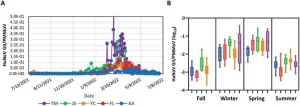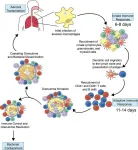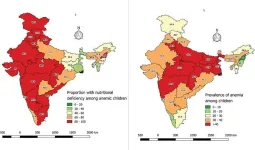(Press-News.org) An international team of researchers has uncovered a remarkable genetic phenomenon in lycophytes, which are similar to ferns and among the oldest land plants. Their study, recently published in the journal PNAS, reveals that these plants have maintained a consistent genetic structure for over 350 million years, a significant deviation from the norm in plant genetics.
"The exceptionally slow pace of genomic evolution sets these plants apart," said Dr. Fay-Wei Li, a professor at the Boyce Thompson Institute and a senior author of the study. "Understanding why these plants have changed so little could reveal important aspects of plant evolution and genetics."
Homosporous lycophytes, a group of seedless vascular plants, show extraordinary genomic stability. The team sequenced the genomes of two species, Huperzia asiatica and Diphasiastrum complanatum, which diverged from a common ancestor about 350 million years ago (approximately when amphibians started to crawl onto land). Surprisingly, it was discovered that about 30% of their genes have remained in the same arrangement since their divergence, exhibiting an unusual evolutionary pattern known as synteny.
"This study opens a window into the past, showing us how remarkably stable the genetic makeup of these plants has been," said Dr. Li Wang, co-author of the study. "It's like finding a living fossil at the genetic level."
The scientists also observed a notable retention of duplicated gene copies following whole genome duplication events, which is unusual. “While a handful of duplicate genes may evolve new roles, the vast majority are lost relatively quickly through a process known as diploidization,” explains Dr. David Wickell, post-doctoral researcher and co-first author of the study.
However, the researchers found that these homosporous lycophytes often retained both sets of genes with relatively few alterations, even after hundreds of millions of years of evolution.
“That homosporous lycophytes have retained so many duplicate genes and so much synteny is fascinating, a little bit surprising, and doesn’t necessarily fit with our traditional ideas of how genomes reorganize themselves after a large-scale duplication,” notes Wickell. “While it’s still unclear precisely what is driving this difference, we believe that further study of homosporous plants has the potential to provide novel insights into plant genetics and evolution across all land plants. It also underscores the importance of preserving biodiversity, as these amazing plants hold vital clues to the history of life on Earth.”
About the Boyce Thompson Institute
Founded in 1924, the Boyce Thompson Institute (BTI) is a premier plant biology and life sciences research institution in Ithaca, New York. BTI scientists conduct investigations into fundamental research to increase food security, improve environmental sustainability, and make basic discoveries that will enhance human health. Throughout this work, BTI is committed to inspiring and educating students and providing advanced training for the next generation of scientists. BTI is an independent nonprofit research institute that is affiliated with Cornell University. For more information, please visit BTIscience.org.
END
A window into plant evolution: The unusual genetic journey of lycophytes
2024-01-18
ELSE PRESS RELEASES FROM THIS DATE:
Climate change linked to spread of diarrheal illness
2024-01-18
Temperature, day length and humidity have been found to be linked to the increased spread of a diarrhoeal illness a new study from the University of Surrey reveals. The findings could help predict further outbreaks of the illness, potentially leading to better preparedness within health services.
During this unique study, researchers led by Dr Giovanni Lo Iacono, investigated the impact of weather on the transmission of campylobacteriosis, a bacterial infection which can cause diarrhoea and stomach pains. According to the World Health Organisation, Campylobacter infections are the most common causes of human bacterial gastroenteritis in the world. Infections are generally ...
Injectable agents could improve liquid biopsy for cancer detection and monitoring
2024-01-18
Scientists have developed two agents, made of therapeutic nanoparticles and antibodies, that could be given to patients shortly before a blood draw to allow physicians to better detect tumor DNA in blood using a technology called liquid biopsy.
Liquid biopsies promise to transform how cancers are diagnosed, monitored, and treated by detecting DNA that tumors shed into the blood. But the body presents a significant challenge. Immune cells in the liver and DNA-degrading enzymes in blood remove circulating tumor DNA from the bloodstream within minutes, making this DNA difficult to capture and detect in a blood test.
To overcome this, a team from the Broad Institute of MIT and Harvard ...
A fungal pathogen, Rosellinia necatrix, that attacks plants, produces antimicrobials to combat the plant-hosted bacteria that would otherwise inhibit its infection success
2024-01-18
A fungal pathogen, Rosellinia necatrix, that attacks plants, produces antimicrobials to combat the plant-hosted bacteria that would otherwise inhibit its infection success.
####
Article Title: The soil-borne white root rot pathogen Rosellinia necatrix expresses antimicrobial proteins during host colonization
Article URL: http://journals.plos.org/plospathogens/article?id=10.1371/journal.ppat.1011866
Author Countries: Germany, Spain, the Netherlands
Funding: EACC and DET acknowledge receipt of PhD fellowships from CONACyT, Mexico. ALM is holder of a postdoctoral research fellow funded by the 'Fundación Ramón Areces'. BPHJT ...
Researchers improve blood tests’ ability to detect and monitor cancer
2024-01-18
CAMBRIDGE, MA -- Tumors constantly shed DNA from dying cells, which briefly circulates in the patient’s bloodstream before it is quickly broken down. Many companies have created blood tests that can pick out this tumor DNA, potentially helping doctors diagnose or monitor cancer or choose a treatment.
The amount of tumor DNA circulating at any given time, however, is extremely small, so it has been challenging to develop tests sensitive enough to pick up that tiny signal. A team of researchers from MIT and the Broad Institute of MIT and Harvard has now come up with a way to significantly boost that signal, by temporarily slowing the clearance of tumor DNA circulating in the bloodstream.
The ...
Sea otters may be key drivers of changes in California's kelp forests, according to data spanning a century
2024-01-18
Sea otters may be key drivers of changes in California's kelp forests, according to data spanning a century
#####
In your coverage please use this URL to provide access to the freely available article in PLOS Climate: https://journals.plos.org/climate/article?id=10.1371/journal.pclm.0000290
Article Title: Sea otter recovery buffers century-scale declines in California kelp forests
Citation: Nicholson TE, McClenachan L, Tanaka KR, Van Houtan KS (2024) Sea otter recovery buffers century-scale declines in California ...
Norovirus outbreaks are detectable by wastewater monitoring earlier than by other surveillance methods depending on reporting practices, making this a potentially important public health tool
2024-01-18
Norovirus outbreaks are detectable by wastewater monitoring earlier than by other surveillance methods depending on reporting practices, making this a potentially important public health tool.
####
Article URL: https://journals.plos.org/water/article?id=10.1371/journal.pwat.0000198
Article Title: Norovirus GII wastewater monitoring for epidemiological surveillance
Author Countries: USA
Funding: This study was supported by funding from the University of Michigan through the Public Health Infection ...
Climate change may reduce life expectancy by half a year, study suggests
2024-01-18
The cost of climate change may be six months off the average human lifespan, according to a study published January 18, 2024, in the open-access journal PLOS Climate by Amit Roy from Shahjalal University of Science and Technology and The New School for Social Research, U.S.
Temperature and rainfall — two telltale signals of climate change — cause myriad public health concerns, from the acute and direct (e.g., natural disasters like flooding and heat waves) to the indirect yet equally devastating (e.g., respiratory and mental illnesses). While impacts like these are observable and well documented, existing research has not established a direct link between climate change and life ...
Remodeling the immune system to fight tuberculosis
2024-01-18
AMHERST, Mass. – Tuberculosis, caused by the bacterium Mycobacterium tuberculosis (Mtb) kills upwards of 1.6 million people a year, making it one of the leading causes of death by an infectious agent worldwide—and that number is only growing larger. How, exactly, Mtb evades the immune system isn’t yet known, but a collaborative team of researchers from the University of Massachusetts Amherst and Seattle Children’s Research Institute recently discovered something surprising: prior exposure to a genus of bacteria called Mycobacterium seems to remodel the first-line defenders in the body’s immune system. Furthermore, how ...
6 in 10 sampled under-5s in India have micronutrient deficiencies, and 4 in 10 have anaemia, per survey of 17,230 children
2024-01-18
6 in 10 sampled under-5s in India have micronutrient deficiencies, and 4 in 10 have anaemia, per survey of 17,230 children.
####
Article URL: https://journals.plos.org/globalpublichealth/article?id=10.1371/journal.pgph.0002095
Article Title: Prevalence and determinants of anemia due to micronutrient deficiencies among children aged 12–59 months in India–Evidence from Comprehensive National Nutrition Survey, 2016–18
Author Countries: India
Funding: The authors received no specific funding for this work. END ...
DNA becomes our ‘hands’ to construct advanced nanoparticle materials
2024-01-18
Evanston, IL In a paper to be published in Science Jan. 18, scientists Chad Mirkin and Sharon Glotzer and their teams at Northwestern University and University of Michigan, respectively, present findings in nanotechnology that could impact the way advanced materials are made.
The paper describes a significant leap forward in assembling polyhedral nanoparticles. The researchers introduce and demonstrate the power of a novel synthetic strategy that expands possibilities in metamaterial design. These are the unusual materials that underpin “invisibility cloaks” and ultrahigh-speed optical computing systems.
"We manipulate ...




